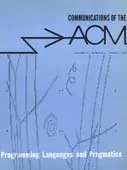March 1966 - Vol. 9 No. 3

Features
Programming semantics for multiprogrammed computations
The structure of programming languages
The next 700 programming languages
Syntax-directed interpretation of classes of pictures
A graphical service system with variable syntax
Program translation viewed as a general data processing problem
An ALGOL compiler: construction and use in relation to an elaborate operating system
Evolution of the meta-assembly program
Requirements for real-time languages
Data manipulation and programming problems in automatic information retrieval
Storage and retrieval of aspects of meaning in directed graph structures
TRAC, a procedure-describing language for the reactive typewriter
On a generalized language for file organization and manipulation
Some preliminary remarks on theoretical pragmatics
The use of English as a programming language
Microprogramming, emulators and programming languages
Advanced programming and the aims of standardization



